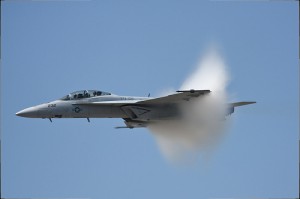On Clean Energy, The Military's Biggest Fight Is With Congress
 For two days in mid-July, 100 miles off the northern coast of Oahu in Hawaii, the U.S. Navy aircraft carrier USS Nimitz played host to the first large-scale demonstration of the Navy’s Great Green Fleet. More than 70 aircraft, including F/A-18 Hornet fighter jets, E-2 Hawkeye early warning aircraft, and helicopters, as well as destroyers and other ships, participated in the biannual Rim of the Pacific naval exercises with sailors and pilots from 21 other nations. A 50-50 biofuel/petroleum blend powered virtually all of the Navy’s ships and aircraft.
For two days in mid-July, 100 miles off the northern coast of Oahu in Hawaii, the U.S. Navy aircraft carrier USS Nimitz played host to the first large-scale demonstration of the Navy’s Great Green Fleet. More than 70 aircraft, including F/A-18 Hornet fighter jets, E-2 Hawkeye early warning aircraft, and helicopters, as well as destroyers and other ships, participated in the biannual Rim of the Pacific naval exercises with sailors and pilots from 21 other nations. A 50-50 biofuel/petroleum blend powered virtually all of the Navy’s ships and aircraft.“The military has done a lot of things that start a tidal wave throughout our culture, and I think this is one of those things,” Navy Lt. Commander Jason Fox, an E-2 Hawkeye pilot, told Forbes.
Meanwhile, stateside in the deserts of California, SunEdison is constructing the massive 350 MW Oro Verde solar PV plant in Kern County that will power part of Edwards Air Force Base where the plant is located. SunPower is preparing for the October opening of a 14.8 MW solar plant at the Naval Air Weapons Station at China Lake. And SolarCity’s SolarStrong initiative for military residential PV installations across the U.S. continues to progress, with last month’s announcement of solar deployments on 850 Air Force Base residences in California and Colorado.
All these activities are part of the U.S. military’s major push into clean energy, a trend presented in this space earlier this year by Environmental Entrepreneurs co-founder Nicole Lederer. In a very bumpy year for the clean-tech industry, the Pentagon’s development of clean energy continues to be one of the brightest lights. It is creating markets and jobs, and seeding next-gen technology developments. At the same time, organizations like Veterans Green Jobs and Airstreams Renewables are promoting training and hiring of military veterans in the clean-tech sector.
The Pentagon has ambitious goals to reduce fossil-fuel use in both combat operations and on bases; the Navy and Air Force, for example, both aim to get half their fuel from non-petroleum sources by 2020. And with good reason: fuel convoys to supply infantry in Iraq and Afghanistan have proven to be one of the most vulnerable aspects in the war theater. In an all-too-common example on July 18, a bomb planted by the Taliban destroyed 22 NATO tanker trucks in northern Afghanistan. This occurred in the same week as the Navy’s Great Green Fleet exercises occurred in Hawaii, showcasing a better way.
But now, in Congress, a great deal of this may be in jeopardy.
In various hearings over the past few months, Senators James Inhofe (R-Okla.) and John McCain (R-Ariz.) and U.S. Rep. Randy Forbes (R-Va.), among others, have opposed the military’s biofuels usage because of high costs. I’m skeptical that other aspects of defense spending are receiving the same fiscal scrutiny–these members of Congress are in the same party whose presumptive presidential nominee Mitt Romney is on record stating, “I will not cut the military budget.”
The Congressional opponents argue that today’s next-generation biofuels, from algae, waste streams, and other feedstocks, are significantly more expensive than fossil fuels, and that is certainly true. But they also argue that it’s not the Pentagon’s role to pay a premium to help bring new technologies to commercial scale that would bring costs down, and that argument conveniently ignores, oh, about 150 years of U.S. military history. As Navy Secretary Ray Mabus often says, “Since the 1850s, the Navy has moved from sail power to coal to oil to nuclear. And every time we changed, plenty of people said the new energy source was too expensive, too hard, and too unproven. But every time, we made a better Navy.”
Indeed, the Navy’s pioneering work on nuclear technology for energy rather than bombs after World War II arguably gave birth to a viable (albeit with sizable government subsidies) nuclear power industry. In a nice historical touch, it was a nuclear-powered ship, the Nimitz, that carried the biofuels-powered aircraft of the Great Green Fleet. And nuclear power is far from the only example. Scores of everyday commercial technologies, from semiconductors to lasers to the Internet, are the direct result of early development work by the Department of Defense.
An F/A-18 Hornet fighter jet is not a research lab; the military is proving that today’s next-gen biofuels perform in operational use, under high-stress conditions with no margin for error. Petroleum replacement fuels will create U.S.-based industries, make military operations safer and more effective, and help reduce our need for military action to defend access to petroleum sources in the first place. Seems to me that’s part of what national security is about. It’s a shame that some in Congress don’t seem to agree.
You can return to the main Market News page, or press the Back button on your browser.

